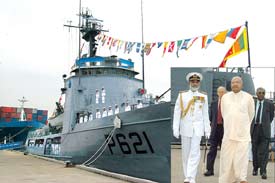Ilankai Tamil Sangam29th Year on the Web Association of Tamils of Sri Lanka in the USA |
|||||
 Home Home Archives Archives |
Moving Globally Against the Tigersby K. Venkataramanan, The Hindu, Chennai, April 1, 2011
Two international ‘contact groups' to check LTTE fund-raising and arms purchases were initiated by the U.S. Concerted international action to curb fund-raising and weapons procurement by the Liberation Tigers of Tamil Eelam (LTTE) started in the first half of 2006, around the time Sri Lanka's fragile ceasefire broke down and an all-out war started. It was the United States that unveiled and initiated the plan to create two international ‘contact groups', one each to move against fund-raising and weapons procurement by the LTTE.
U.S. Embassy cables accessed by The Hindu through WikiLeaks reveal that Sri Lanka was excited about the proposal and wanted to bring India on board to operationalise the contact groups. The Americans believed that India “was on the same page” as them on what to do about the stalled peace process — “getting the President [Mahinda Rajapaksa] to fill in the details of a political solution to deflate LTTE claims that the GOSL [Government of Sri Lanka] was ignoring Tamil aspirations — and working to cut off LTTE access to weapons and money.” These were the words in a cable sent to the State Department under the name of U.S. Ambassador in Colombo Jeffrey J. Lunstead on May 3, 2006, eight days after the LTTE tried to assassinate Sri Lankan Army Commander Sarath Fonseka (62637: confidential). Over the next couple of months, there are repeated references in cables to the ‘contact groups.' Their composition is revealed in an Aide Memoire that Sri Lanka submitted to the U.S. in August 2006. Despite indications in cables that date back to June that year that India was quite happy with the idea of the contact groups, Sri Lanka requested in the Aide Memoire for U.S. help to put pressure on India to get on board the international plan to rein in Tiger finances and arms purchases. The Aide Memoire, quoted in full in an August 21, 2006 cable sent from the U.S. Embassy in New Delhi, discloses the composition of the contact groups for the first time: representatives of Australia, Belgium, Canada, France, Germany, India, Indonesia, Italy, Japan, Malaysia, the Philippines, Singapore, Switzerland, Thailand, the United Kingdom and the United States (75589: confidential). The May 3 cable recounts an interaction between the U.S. Political Officer in Colombo and India's First Secretary Amandeep Singh Gill. It is clear that India was pushing Sri Lanka to come out with a political solution, but had made little headway in its efforts. On June 12, the Acting Political Counselor in the U.S. Embassy in New Delhi met Mohan Kumar, Joint Secretary (Bangladesh, Sri Lanka, Myanmar) in the Ministry of External Affairs, to deliver a demarche, presumably containing the action plan on the contact groups. A cable, sent on the same day, said: “Kumar said he had ‘previously discussed the idea with [Foreign Secretary] Saran', and thought it made sense to have two distinct contact groups to examine LTTE fundraising and arms procurement.” (67636: confidential). It was signed by Ambassador David Mulford. Mr. Kumar wanted Canada to be included in the contact group dealing with terror-financing, but did not have any additional comments regarding the group's composition. The cable recounted an earlier conversation with an American representative in which he had suggested involving South-East Asian states such as Thailand and Malaysia to restrict arms flows, “and therefore [he] was pleased at the proposed composition of the weapons procurement contact group.” On June 20, Mr. Lunstead called on his Indian counterpart, Nirupama Rao, in Colombo to discuss the possibility of a joint demarche by India and the U.S., and the plan to form contact groups. “Rao thought this was a good idea,” Mr. Lunstead said in a cable to the State Department on June 21 (68835: confidential). Ms. Rao was not “encouraging” on the idea of a joint demarche. In New Delhi on June 22, S. Jaishankar, Joint Secretary (Americas) at the MEA, called the Acting Political Counselor in the U.S. Embassy “to relay the considered Indian response” that it favoured parallel demarches to Sri Lanka instead of a joint demarche because it would have a “better impact.” Mr. Mulford said in a cable sent the same day: “India was amenable to coordinating messages prior to delivery.” (69020: confidential). Foreign Secretary Shyam Saran visited Colombo in the first week of July. Later that month, the Sri Lankan Army formally crossed the ceasefire line to free a reservoir that the LTTE had shut down and refused to reopen, marking the beginning of a prolonged military operation that culminated in the liberation of the eastern region in 2008. Even during this phase, India was pushing for a political solution. This was the theme of an August 18, 2006 cable from the U.S. Embassy in Delhi (75386: confidential). Small wonder, then, that Sabarullah Khan, the Sri Lankan Deputy High Commissioner in New Delhi, submitted an Aide Memoire to the Acting Political Counselor in the U.S. Embassy. “Khan said that the GOSL is pressing the Indians to come up with more concrete plans for resolution of the ongoing conflict and more movement on the contact groups concept.” And Mr. Khan added: “…the Government of Sri Lanka would greatly value the support of the Government of India for the initiative taken by the State Department of United States and the comprehensive participation of India in the work of the two Contact Groups” (75589: confidential, dated August 21, 2006, also cited above). (This article is a part of the series "The India Cables" based on the US diplomatic cables accessed by The Hindu via Wikileaks.)
| ||||
